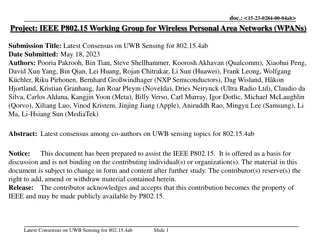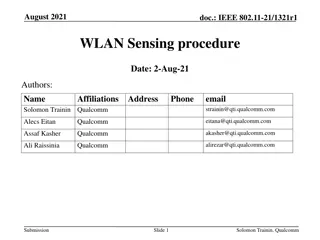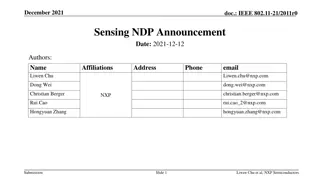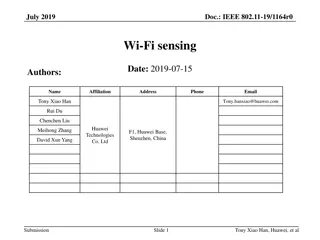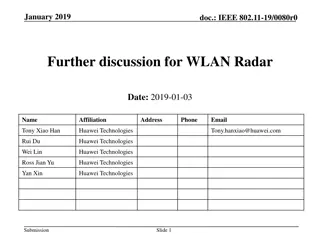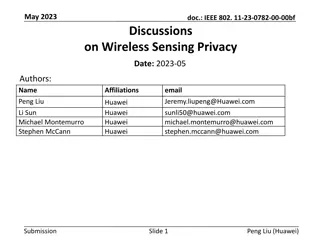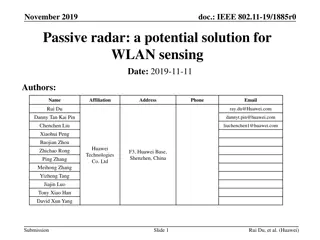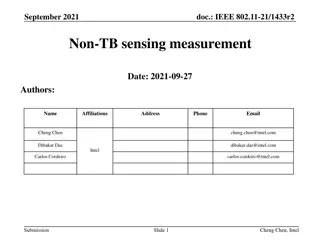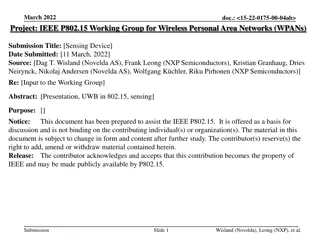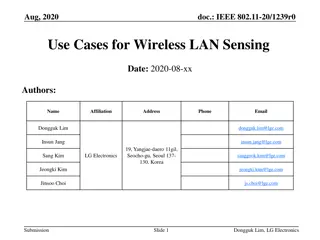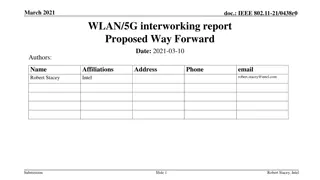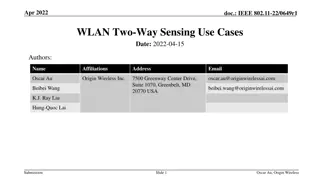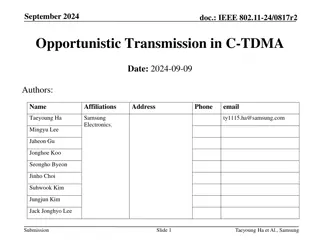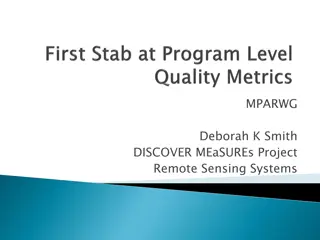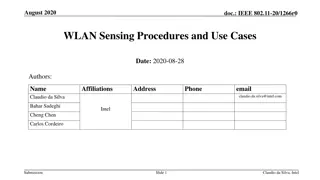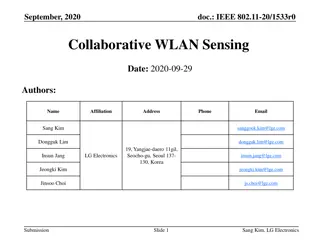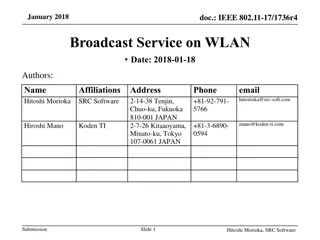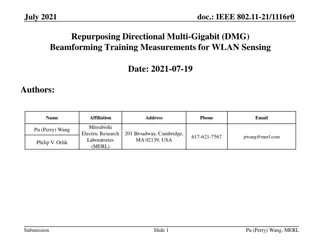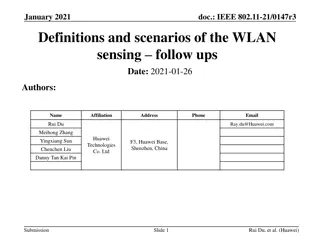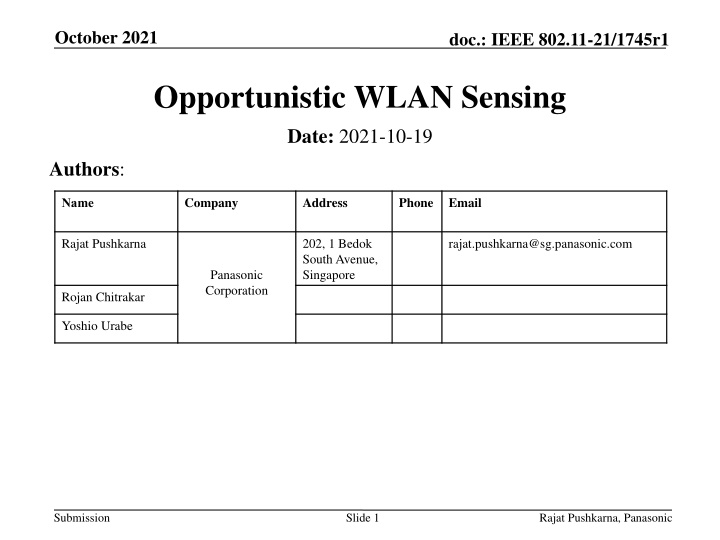
IEEE 802.11-21 Opportunistic WLAN Sensing Protocol Overview
Explore the IEEE 802.11-21 standard amendment focusing on opportunistic WLAN sensing for channel measurements using regular PPDU exchanges. The document discusses the phases of WLAN sensing protocol, proposals for opportunistic channel measurement, and the significance of sensing-related frame exchanges in sub-7 GHz bands.
Download Presentation

Please find below an Image/Link to download the presentation.
The content on the website is provided AS IS for your information and personal use only. It may not be sold, licensed, or shared on other websites without obtaining consent from the author. If you encounter any issues during the download, it is possible that the publisher has removed the file from their server.
You are allowed to download the files provided on this website for personal or commercial use, subject to the condition that they are used lawfully. All files are the property of their respective owners.
The content on the website is provided AS IS for your information and personal use only. It may not be sold, licensed, or shared on other websites without obtaining consent from the author.
E N D
Presentation Transcript
October 2021 doc.: IEEE 802.11-21/1745r1 Opportunistic WLAN Sensing Date: 2021-10-19 Authors: Company Address Phone Email Name Rajat Pushkarna 202, 1 Bedok South Avenue, Singapore rajat.pushkarna@sg.panasonic.com Panasonic Corporation Rojan Chitrakar Yoshio Urabe Submission Slide 1 Rajat Pushkarna, Panasonic
October 2021 doc.: IEEE 802.11-21/1745r1 Background The P802.11bf PAR[1] defines that the amendment enables a WLAN sensing measurements to be obtained using transmissions that are requested, unsolicited, or both. [2] Motion 22 states, Measurement phase of sensing session, the NDP can be used for the channel measurement (e.g., CSI) between sensing transmitter and sensing receiver(s) in sub 7Ghz band. [3] Motion 20 states, CSI (that is, the channel measured during the training symbols of a received PPDU) is a type of sensing measurement result for sub-7 GHz WLAN sensing. In this contribution, we discuss about the regular PPDU (A regular PPDU is defined as any PPDU which is not an NDP for sensing) exchange which can be utilized to perform sensing measurement and obtain CSI for sub-7GHz. Submission Slide 2 Rajat Pushkarna, Panasonic
October 2021 doc.: IEEE 802.11-21/1745r1 Proposal 802.11bf should allow opportunistic channel measurement based on PPDUs other than NDP for WLAN Sensing. Control Time Feedback Time Data PPDU Data PPDU NDPA NDP STA 1 Explicit Feedback ACK ACK STA 2 Sensing related frame exchange Ongoing regular communication Opportunistic Sensing Sensing using NDP The following equations provides an insight of the overhead related to sensing related frame exchange, NDPA = 24+CEILING( 21 8+4 8 numUsers,24 )/24 4 NDP = 36+16 numHeltfSymbol Explicit Feedback = 40+16 numHeltfSymbol+700 4 numStream(=4) Control time = NDPA + SIFS = (approx. 60us for MCS 0) Feedback time = SIFS+explicit feedback = (approx. 88us for MCS 0) Opportunistic WLAN Sensing has already been proposed in [4]. Sensing overhead can be reduced for some cases if we enable opportunistic channel measurement by PPDUs other than NDPs(for example, data frames). Slide 3 Submission Rajat Pushkarna, Panasonic
October 2021 doc.: IEEE 802.11-21/1745r1 Sensing Protocol For WLAN Sensing protocol, three phases can be considered [2]: Initiator Responder Measurement phase comprise of: Channel measurement Feedback(optional) Session Setup Measurement Setup Measurement Setup termination Submission Slide 4 Rajat Pushkarna, Panasonic
October 2021 doc.: IEEE 802.11-21/1745r1 Channel Measurement based on Regular PPDU - 1 PHY Header MAC Header Regular PPDU Regular PPDU Regular PPDU Sensing measurement setup Phase STA 1 (responder/transmitter) Teardown ACK ACK STA 2 (initiator/receiver) Measurement Phase During the measurement session setup phase, capabilities like, transmit periodicity, measurement session setup ID etc are negotiated. The channel can be measured by STA receiving the PPDU using the Long Training Field present in the PHY preamble of the received PPDU. Submission Slide 5 Rajat Pushkarna, Panasonic
October 2021 doc.: IEEE 802.11-21/1745r1 Regular PPDUs to be considered for WLAN Sensing - 1 Beacon frames: AP as sensing initiator can make use of Beacon frames to perform channel measurements. The advantage of using Beacon frames for WLAN Sensing is that beacon frames are transmitted every Beacon Interval. Therefore, it can help achieve periodic sensing. Beacon frames are transmitted at 20MHz bandwidth and at a lower MCS providing robust transmission therefore can the chances of failure are very less. The disadvantage of using beacon frames for WLAN sensing is that only a part of full bandwidth can be sensed, the transmission interval is fixed and are transmitted with a single LTF. [5] provides examples of WLAN sensing using beacon frames. Submission Slide 6 Rajat Pushkarna, Panasonic
October 2021 doc.: IEEE 802.11-21/1745r1 Regular PPDUs to be considered for WLAN Sensing - 2 Data frames: The preferred option of channel measurement using PPDUs other than NDP are Data frames. The advantage of using Data frames for channel measurement is that it does not require transmission of frames exclusively for sensing. Data PPDUs are transmitted at higher bandwidth, can carry more LTFs and, thus it can sense a significant part of the channel. We performed experiments using Data frames for presence detection at 80MHz and achieved accuracy of around 94%. Therefore, for certain application we can consider using data frames for channel measurement. Slide 7 Submission Rajat Pushkarna, Panasonic
October 2021 doc.: IEEE 802.11-21/1745r1 Signalling the Tx parameters The transmit parameters can be indicated by the transmitter in subsequent PPDUs if the transmitter changes the transmit parameters. The transmitter can indicate the change in transmit parameters as follows: The transmitter after beamforming shall indicate the receiver about the change in transmit parameters if any, e.g., using an indication in the MAC header of the PPDU. The actual indication can be discussed. A new management frame can be defined which may be transmitted by the transmitter upon change in Tx parameters. The format of the management frame is TBD. Submission Slide 8 Rajat Pushkarna, Panasonic
October 2021 doc.: IEEE 802.11-21/1745r1 Signalling Tx Parameters STA AP Sensing Discovery Beacon/Probe Response (WLAN Sensing Capabilities) Measurement Setup IDis negotiated during Sensing Setup phase (It may be included in Sensing Setup Request or Response) Sensing Setup Request Sensing Setup Sensing Setup Response (Status: Accept/Reject), Measurement Setup ID :: Regular PPDUs may include the Measurement Setup IDin its payload, for example, in an A- control field in MAC frame carried in the PPDU. Sensing transmitter shall not include the Measurement Setup ID with the same value if TX parameters for sensing is different. By this rule, the sensing receiver can recognize that the PPDUs including the same Measurement Setup ID value have the same TX parameters for sensing Regular PPDU Regular PPDU Sensing Measurement :: :: Sensing Termination Request Sensing Teardown (Optional) Motion 24 describes that, The Measurement Setup ID may be used to identify attributes of the sensing measurement instances. Submission Slide 9 Rajat Pushkarna, Panasonic
October 2021 doc.: IEEE 802.11-21/1745r1 When WiFi traffic is not available Sensing measurement PPDUs can be for example, QoS Null Data frames Submission Slide 10 Rajat Pushkarna, Panasonic
October 2021 doc.: IEEE 802.11-21/1745r1 Simulation Scenario We performed experimentation using PPDUs carrying data frames for WLAN Sensing. The simulation scenario was as follows: Simulation Scenario: Distance: 5 meters PPDU: PPDUs carrying data frames. Bandwidth for packet transmission: 80MHz Transmitter: 802.11ac capable. Receiver: Nexus handphone Transmitter Receiver Submission Slide 11 Rajat Pushkarna, Panasonic
October 2021 doc.: IEEE 802.11-21/1745r1 Experimentation Results The achieved results were able to achieve an accuracy of more than 90% and could be used for various applications, like people counting, presence detection, motion detection etc[6]. Detection using Regular PPDU Submission Slide 12 Rajat Pushkarna, Panasonic
October 2021 doc.: IEEE 802.11-21/1745r1 Conclusion In this contribution we propose an opportunistic way to measure the channel between an initiator and responder using regular PPDU. The advantage of using regular PPDU for channel measurement is that, it can be done simultaneously with data communication and may help in reducing sensing related overhead. Submission Slide 13 Rajat Pushkarna, Panasonic
October 2021 doc.: IEEE 802.11-21/1745r1 Straw Poll SP : Do you support that PPDUs other than NDP may be used for channel measurement for WLAN Sensing? Note: (PPDU type/format is TBD) Yes/No/Abstain Submission Slide 14 Rajat Pushkarna, Panasonic
October 2021 doc.: IEEE 802.11-21/1745r1 References [1] 11-19/2103r12, 802.11 SENS SG Proposed PAR, Claudio da Silva. [2] 11-21/419r1, Sensing Measurement sequence of 11bf, Dongguk Lim. [3] 11-21/0908r2, Sensing Measurements: Interfaces and Reporting, Claudio DaSilva. [4] 11-21/1581, Opportunistic WLAN Sensing, Chris Beg. [5] Wi-ESP A tool for CSI-based Device-Free Wi-Fi Sensing., Muhammad Atif, Journal of Computational Design and Engineering. [6] WiFi Sensing, WiFi Alliance Whitepaper. Submission Slide 15 Rajat Pushkarna, Panasonic

